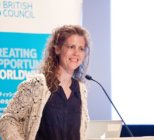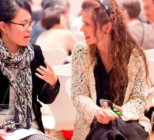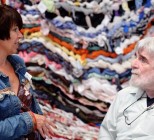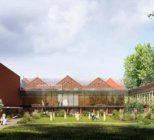We reopened our doors to the public at 10am on Valentine’s Day. Our first visitor was a slightly bemused toddler, who marched his family across the threshold, onwards and upwards to the Grand Hall, where our first event was Brass Baby, a specially commissioned musical experience for our youngest visitors from Northern Brass. Thereafter, people just kept coming. We welcomed 18,000 visitors during our opening weekend, more than used to visit in a month.

We worked hard to create an opening programme that showed off our spaces and the very best of Manchester and there were some jaw-dropping moments, including a wonderful performance from Halle Youth choir singing Jerusalem to a backdrop of images by William Blake and fireworks in the Art Garden.
What I remember most from the opening weekend are the good, odd things; the couple on a first date who’d driven up from London that day; the sight of families parading across the park on one of our Whitworth welly walks; the sense of relief and pride as it dawned on Whitworth Young Contemporaries that the gig/event they’d been working on for months was a sell-out success; the hunt for ever more toilet rolls; the energy and excitement of our new volunteers and finally, Maria’s [Maria Balshaw the Director] emotional thank you to visitors at the end of the weekend as she reflected on just how far we’d come and the spectacle of queues of people outside, throughout the day, waiting to come in to their gallery.

As anyone involved in a large capital project knows, it’s a long journey – exhilarating, exhausting, extraordinary (and often all three at once). For me, it started back in the late 1990s when the Whitworth took a chance (I was their ‘wildcard’ candidate) and appointed me as the gallery’s first ever education officer. On day one, nervous and excited, I gazed in awe at William Blake’s visionary work Ancient of Days, only to round the corner and be greeted by a Captain Pugwash wallpaper. This eclecticism is, for me, pure Whitworth and one of the things I have always loved. We’ve often described it as ‘good and odd’. I think the Whitworth was always good and odd, but it took Maria Balshaw’s leadership to realise its potential. Over the past few years, the gallery has changed hugely. So has my role and I now lead the largest team at the Whitworth; 12 programmers/educators, the Visitor team, creative practitioners and over a hundred volunteers. Visitor figures have doubled as our programming has become ever more ambitious. By the time we closed in September 2013, we were bursting at the seams.
Since we closed, we’ve been doing things a bit differently. This period represented a huge opportunity and challenge to stay connected to established audiences and build new ones. We did what many organisations do while closed, we ran extensive off-site activities and worked in 30 sites across the city, directly engaging 6,900 people of all ages. Pop-up Whitworth’s appeared all over the place, drawing on collections and expertise and connecting us to diverse audiences; from a pop-up exhibition and engagement programme in Selfridges Manchester seen by their 200,000+ customers to an Easter pop-up at Asda which reached over 300 families who’d never visited the gallery, only half a mile from their homes. Our award-winning early years programme continued in venues including the Bridgewater Hall (with Halle, RNCM), Z-Arts, MELA festival and Boots in the Arndale Centre. After Hours, our adult art and social programme, became The Whitworth Pub Crawl (in partnership with Workers Educational Association) and took place across local pubs and breweries with live music, art, performance and learning.

These activities undoubtedly raised profile and awareness across the city and kept us focused as we moved out and building work started in earnest. But this was also a once in a generation chance to build local partnerships and extend our reach. The Whitworth is international, but is also Moss Side’s local gallery. So, during the closure period, each member of my team ‘lived’ with a neighbour, worked in a new environment (a day a week) and built new partnerships. The gallery’s adult programmer worked in a residential care home, exploring how older people connect with the gallery and creating age-friendly resources; Arts for Health Manager strengthened NHS partnerships developing creative work supporting rehabilitation from stroke and for people living with dementia; Formal learning staff spent time in schools (including a wood/forest school) colleges and the Students Union piloting programmes, designing child-led guides and training; Youth Programmer worked with Barnados, House of Manchester and Moss Side Powerhouse to create a new programme for hard to reach 15-25 year olds. We drank a lot of tea, reached out and made friends in unfamiliar organisations and communities.
We’ve talked about how, in some ways, we were never more open than when we were closed. As a result, strengthened partnerships now underpin programmes for the new Whitworth; including Whitworth Stroke café (Stroke Association), Whitworth Young Contemporaries Speaks (Moss Side Powerhouse), Handmade artclub older men’s programme (Age Friendly Manchester) and Artmed GP training programme (Central Manchester Hospitals).
A month on and we’re getting to grips with our new building. We’re learning what works and what doesn’t. There are the inevitable teething problems and every day brings a new challenge and insight. Some of our programmes are up and running, others are still in development and being tested. We don’t want to rush and we want to get it right, so we’re taking it slowly, listening to feedback, adapting what we do so it works.
Yesterday, as I stood in the newly planted (and sunny) Art Garden with a group of teachers (part of a curious minds programme called SLICE, Specialist Leaders in Cultural Education), we talked about the possibilities and potential the Whitworth might hold for their children and teaching in the coming years. It’s been a while coming, but this is what we do best and this is what we’ve been waiting for.
Back to top









